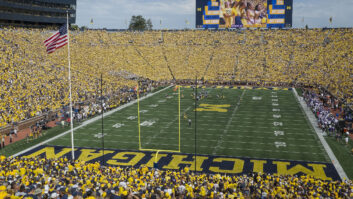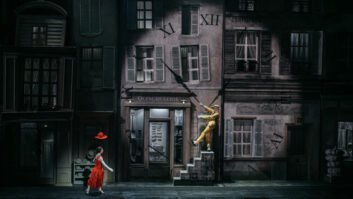
Back in August, MTV hosted its 36th annual Video Music Awards (VMA) at the Prudential Center in Newark, USA.
The show, which attracted over 1.5 million viewers, was facilitated by ten disguise gx 2 media servers deployed by entertainment design firm Visual Noise Creative.
The annual event featured an “eye-popping array” of video elements throughout the show, ranging from performance graphics and stage design down to the listings of performers and presenters.
“MTV and Viacom continues to push the limits on television production year over year, and for us that means new scenery with massive amounts of integrated video,” said Trevor Burk, creative director and screens producer at Visual Noise Creative.
This set design this year was no exception, and it required a platform that enabled appropriate creativity, flexibility and speed.
Burk added: “We have found that the disguise ecosystem programmed on a console allows us to work at the pace of a broadcast awards show and handle the inevitable curveballs that come with putting a show that size together in a matter of days.
“On a show like this, the use of screens transcends video and actually becomes all of the scenic environment and one that puts off a massive amount of light. We need to be able to collaborate alongside the production designer and lighting designer to help create pictures that blur the output of those departmental lines. We can only achieve this if we have a toolset that is robust enough to keep up.”
The complexity of this year’s show with its numerous video elements made the gx 2s particularly noteworthy to capture positional data from VTProDesign’s KUKA robots.
“We had a couple of opportunities to explore integrations that were beyond the typical awards show format,” Burk said. “First, we collaborated with VTProDesign, which programmed the four KUKA robots, two of which had LED screens attached. Taking
data and sync information from VTPro we were able to utilise both synced
video/automation moves as well as parallel mapped content with OSC motion data.
“The second unique opportunity came when talking with art directors Matt Steinbrenner and Gloria Lamb and head stage manager Gary Hood,” he added.
“They asked us to explore ways to avoid tape spike marks that fill the stage in a typical broadcast music variety award show marking band gear and scenery for all the acts. To integrate real-time inputs that could be managed and programmed from the floor we needed a virtual spike mark approach that wouldn’t distract from the limited time we have to programme an act.”
Screens programmer Kirk Miller explained: “Consequently, software developer and programmer Joe Bay, along with the team at Earlybird, built a virtual SpikeMark app for the stage management team. The software utilised an iPad, a wireless network and a server to add digital spike marks to the floor for each performance. We utilised the disguise Web Layer to overlay the virtual canvas seamlessly on top of the show content.”







